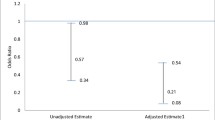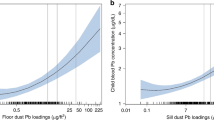Abstract
Controlling residential lead hazards is critical for case management of lead poisoned children. To attain this goal, permanent relocation of the family is sometimes necessary or advisable for many reasons, including poor housing conditions; extensive lead hazards; lack of abatement resources, landlord compliance and local enforcement capacity; and family eviction. During 1996–1998, the Kennedy Krieger Institute implemented a unique capitated program for case management of Baltimore City children with blood lead concentrations (PbB) >19 μg/dL. The Program provided financial, housing, and social work assistance to facilitate relocation as a means of providing safer housing. Nearly half of the Program families relocated with direct assistance, and 28% relocated on their own. The Program evaluation examined the costs and benefits of relocation. Average relocation cost per child was relatively inexpensive (<$1,500). Average relocation time of 5 months (range <2 months to >12 months) was less than the 8-month average time to complete lead hazard control work in 14 city and state programs funded by U.S. HUD. Relocation was associated with (1) a statistically significant decrease in dust lead loadings on floors, windowsills and window troughs that persisted for one year, and (2) statistically significantly greater decreases in children’s PbB compared to children who did not relocate from untreated homes. Children relocated to housing that met current Federal residential dust lead standards had statistically significant decreases in blood lead levels. Visual inspection did not consistently identify relocation houses with dust lead levels below current Federal standards, indicating that dust testing should be an essential component of future programs. This will require additional resources for dust testing and possibly cleaning and repairs but is expected to yield additional benefits for children. The findings support recent U.S. CDC case management recommendations suggesting that permanent relocation to safer housing is a viable means to reduce children’s lead exposure. The benefits of relocation notwithstanding, 40% of families moved at least twice. Research is needed to better understand how to expedite relocation and encourage families to remain in safe housing. Relocation does not negate owners’ and health authorities' responsibilities to address lead hazards in the child's original house in order to protect future occupants.

Similar content being viewed by others
References
Chisolm JJ Jr, Kaplan E. Lead Poisoning in childhood-comprehensive management and prevention. J Pediatr. Dec 1968;73:942–950.
Chisolm JJ Jr, Mellits ED, Quaskey SA. The relationship between the level of lead absorption in children and the age, type, and condition of housing. Environ Res. 1985;38:31–45.
Davoli, CT. Use of capitated reimbursement to provide comprehensive management of childhood lead poisoning. Am J Public Health. Dec 1997;87(12):2056–2057.
Davoli CT, Warren LR. A Medicaid Managed Care Community Lead Poisoning Prevention and Treatment Model. Center for Health Strategies, Inc. Available at: http://www.chcs.org/publications/pdf/mcbps/MCBPCommunityLeadPoisoning.pdf. Accessed May 1, 2003].
Warren, LR. The Effects of a modified capitation plan on the management of children with lead poisoning. (Doctoral dissertation, The Johns Hopkins University, 1998). UMI Dissertation Services. Ann Arbor MI, 1998.
U.S. HUD Guidelines for the Evaluation and Control of Lead-Based Paint Hazards in Housing, HUD No. 6700. Washington, D.C.: U.S. Department of Housing and Urban Development; 1995.
Annotated Code of Maryland. 1988. Procedures for abating lead containing substances from buildings. Effective date: August 8, 1988. Maryland Department of the Environment. COMAR 26.02.07.
City of Baltimore. 1987. Rules and Regulations Governing Housing, Regulation 5: Lead-based Paint Abatement. Effective July 1, 1987.
Bannon DI, Murashchik C, Zapf CR, Farfel MR, Chisolm JJ Jr. Graphite furnace atomic absorption spectroscopic measurement of blood lead in matrix-matched standards. Clin Chem. Sep 1994;40(9):1730–1734.
Hornung WR, Reed LD. Estimation of average concentration in the presence of nondetectable values. Appl Occup Environ Hyg. 1990;5:46–51.
SAS Institute (1989–1996). The data analyses for this paper were generated using SAS/SATA software, Version 6.12 of the SAS System for Windows. Copyright © 1989–1996. SAS Institute Inc. SAS and all other SAS Institute Inc. product or service names are registered trademarks of SAS Institute Inc., Cary, NC, USA.
U.S. EPA. Guidance on Identification of Lead-Based Paint Hazards; Notice. Fed Regist. 1995;60(175):47248–47257.
U.S. EPA. Identification of Dangerous Levels of Lead; Final Rule, 40CFR745. Fed Regist. 2001;66(4):1206–1240.
Centers for Disease Control and Prevention. Managing Elevated Blood Lead Levels Among Young Children: Recommendations from the Advisory Committee on Childhood Lead Poisoning. Atlanta: CDC; 2002.
Urban Institute Report for Health Policy for Low Income People in Maryland. April 1999.
Schultz B, Pawel D, Murphy A. A retrospective examination of in-home educational visits to reduce childhood lead levels. Environ Res. May 1999;80(4):364–368.
U.S. Environmental Protection Agency. 1998. Review of Studies Addressing Lead Abatement Effectiveness: Updated Edition. EPA 747-B-98-001. December 1998, US-EPA Office of Pollution Prevention and Toxics, Washington DC 20460.
Annotated Code of Maryland, 1994, Title 26, Department of the Environment, Subtitle 16: Lead Environmental Article, Title 6, Subtitle 8, Reduction of Lead Risk in Housing. Authority: Environmental Article∼∼1-404, 6-801 to 6-852, 6-1001 to 6-1005.
Lanphear BP, Winter NL, Apetz L, Eberly S, Weitzman M. A randomized trial of the effect of dust control on children's blood lead levels. Pediatrics. 1996;98:35–40
Lanphear BP, Howard C, Eberly S, et al. Primary prevention of childhood lead exposure: a randomized trial of dust control. Pediatrics. Apr 1999;103(4 Pt 1):772–777.
Acknowledgements
The evaluation described in this article was funded by the National Center for Healthy Housing using seed money from the Fannie Mae Foundation. The Fannie Mae Foundation, the J.C. Penney Foundation, and the U.S. Department of Housing and Urban Development provided funding for the data analysis. We thank the participating families and Program staff at the Kennedy Krieger Institute who developed and implemented this unique Program, including Michelle Warner, Veronica Kestenburg, Mary Snyder-Vogel and Cecilia Davoli, MD, of the Lead Poisoning Treatment and Prevention Program. We also thank Sandy Roda, Director of the Hematology and Environmental Laboratory, University of Cincinnati, for her assistance with quality control for lead dust testing.
Author information
Authors and Affiliations
Corresponding author
Additional information
McLaine, Shields, and Dixon are with the National Center for Healthy Housing; Farfel is with the Kennedy Krieger Institute and the Johns Hopkins Bloomberg School of Public Health, Department of Health Policy and Management, Baltimore, Maryland; Chisolm (deceased) was with the Kennedy Krieger Institute and the John Hopkins School of Medicine.
Rights and permissions
About this article
Cite this article
McLaine, P., Shields, W., Farfel, M. et al. A Coordinated Relocation Strategy for Enhancing Case Management of Lead Poisoned Children: Outcomes and Costs. JURH 83, 111–128 (2006). https://doi.org/10.1007/s11524-005-9011-8
Published:
Issue Date:
DOI: https://doi.org/10.1007/s11524-005-9011-8




